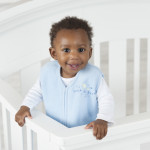 Last week, KID shared the following statement online via our Facebook and Twitter sites:
Last week, KID shared the following statement online via our Facebook and Twitter sites:
“2 out of 3 babies who died while sleeping were sharing an adult bed, couch, or chair. Put baby alone in the crib”
The response to the post was overwhelmingly positive. However, we can’t ignore the critical reactions to the information we shared. Most people who responded focused on sleeping in a bed with a baby, but it’s important to note the statistic includes babies sleeping on couches and chairs as well. It also includes babies sleeping on adult beds alone or with siblings. While we cannot respond to each person individually, what we can do is address some of the overriding concerns with the information we shared.
Response: Where did you get this information? The post wasn’t even cited!
Reply: The image you see is from the Ohio Department of Health’s safe sleep website. This is a credible source of health information that is influenced by the American Academy of Pediatrics safe sleep recommendations. We should have cited this information with the post, and going forward, we will make it a habit to cite data.
Response: I slept with my babies and everything was fine! I would do it again!
Reply: We often hear comments like this from parents. While we understand and respect their sentiments, the ongoing learning process regarding safety cannot be ignored. For example, years ago parents drove away from the hospital with their babies in their arms. In many parts of the world, this is still the case. Most new babies made it home just fine despite not being in a car seat. However, we now know that children should be in car seats in order to travel safely. As a result, every state in the US requires that children ride in a car seat. In addition, the American Academy of Pediatrics recommends that all newborns discharged from hospitals are brought home in infant car seats.
The case of safe sleep is similar. What we know about safe sleep has changed and as an organization, it is our duty to share that information with parents and caregivers. Ultimately, a parent decides for themselves how and if they will use this information, but we would be remiss to withhold the information simply because we know some people will not agree.
Response: I am a proud co-sleeper. Babies belong next to their mommas!
Reply: We couldn’t agree more, babies belong near their parents. That’s why we recommend room sharing without bed sharing. This way, baby is close to mom and dad but in their own crib, play yard, or bassinet designed and tested especially for infant sleep.
As a product safety organization, KID has been a constant force in the product safety world for over 15 years advocating for tougher testing and safety standards for products so parents can trust that the products they use to care for baby will be safe. The new crib, play yard, and bassinet safety standards that have been developed over the past few years in the US have all been shaped in part by KID’s voice with parents and children at the heart of our efforts.
Response: Enough of this fear mongering! Parenting is hard enough without you scaring us.
Reply: We take this criticism to heart and we are truly sorry if people feel this way about messaging from our organization. KID was founded by parents for parents; our intention is to not scare but empower parents with credible information. Many of the parents that we work with never imagined that a product made for their child would end up injuring or killing them. That’s why we work every day to change the story for future children. We do this by challenging manufacturers to make children products safer, collaborate with future engineers to design products with safety in mind, and serve as a safety resource to parents and caregivers so they have what they need to keep their children safe.
We hope this sheds some light on the information that we shared last week and our views of what constitutes safe sleep. As we said, part of our mission is to share information with parents and caregivers. However, it is ultimately up to them what choice they will make for their family.



2 Comments
Deborah Robinson
Great article~
Sara Tamburrino
I wanted to say thank you for sharing this information. When my son was born in 1992, I was a part of the group that thought that sleeping in the adult bed with your babies was the best thing to do. As a result he died. Not all babies die, but the majority of babies who die of these causes are sleeping with their parents. Also most of them are not drunk or on drugs and I was not. I work with parents who had their babies in bed with them and they also died. You may not think that you can roll onto our child, thinking that you are aware of your child's presence but when you are really tired, parents can do these things. I was a sober, 100% breastfeeding mom, whose baby died, and I am not the only one who this has happened to. I now work with many parents who also had their babies die under similar circumstances. Thanks so much KID IN DANGER for publishing this information.